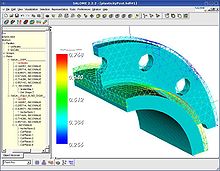Computer-aided engineering: Difference between revisions
interwiki to sk |
No edit summary |
||
| Line 48: | Line 48: | ||
{{Commons category|Computer Aided Engineering (CAE)}} |
{{Commons category|Computer Aided Engineering (CAE)}} |
||
* [http://caejournal.com Computer Aided Engineering Journal] (FEA, CAD, ...) |
* [http://caejournal.com Computer Aided Engineering Journal] (FEA, CAD, ...) |
||
* [http://http://www.iospress.nl/journal/integrated-computer-aided-engineering Integrated Computer Aided Engineering Journal] |
|||
* [http://www.eng.fea.ru/ANSYS_LSDYNA_AviGallery.html CAE AVI-gallery at CompMechLab site, Russia] |
* [http://www.eng.fea.ru/ANSYS_LSDYNA_AviGallery.html CAE AVI-gallery at CompMechLab site, Russia] |
||
* [http://www.wiley.com/bw/journal.asp?ref=1093-9687 Computer-Aided Civil and Infrastructure Engineering] |
* [http://www.wiley.com/bw/journal.asp?ref=1093-9687 Computer-Aided Civil and Infrastructure Engineering] |
||
Revision as of 14:47, 23 January 2012

Computer-aided engineering (CAE) is the broad usage of computer software to aid in engineering tasks.[1][2][3] It includes computer-aided design (CAD), computer-aided analysis (CAA), computer-integrated manufacturing (CIM), computer-aided manufacturing (CAM), material requirements planning (MRP), and computer-aided planning (CAP).[4][5][6]
Übersicht
Software tools that have been developed to support these activities are considered CAE tools. CAE tools are being used, for example, to analyze the robustness and performance of components and assemblies. The term encompasses simulation, validation, and optimization of products and manufacturing tools. In the future, CAE systems will be major providers of information to help support design teams in decision making.
In regard to information networks, CAE systems are individually considered a single node on a total information network and each node may interact with other nodes on the network.
CAE systems can provide support to businesses. This is achieved by the use of reference architectures and their ability to place information views on the business process. Reference architecture is the basis from which information model, especially product and manufacturing models.
The term CAE has also been used by some in the past to describe the use of computer technology within engineering in a broader sense than just engineering analysis. It was in this context that the term was coined by Jason Lemon, founder of SDRC in the late 1970s. This definition is however better known today by the terms CAx and PLM.[citation needed]
CAE fields and phases
CAE areas covered include:
- Stress analysis on components and assemblies using FEA (Finite Element Analysis);
- Thermal and fluid flow analysis Computational fluid dynamics (CFD);
- Kinematics;
- Mechanical event simulation (MES).
- Analysis tools for process simulation for operations such as casting, molding, and die press forming.
- Optimization of the product or process.
In general, there are three phases in any computer-aided engineering task:
- Pre-processing – defining the model and environmental factors to be applied to it. (typically a finite element model, but facet, voxel and thin sheet methods are also used)
- Analysis solver (usually performed on high powered computers)
- Post-processing of results (using visualization tools)
This cycle is iterated, often many times, either manually or with the use of commercial optimization software.
CAE in the automotive industry
CAE tools are very widely used in the automotive industry. In fact, their use has enabled the automakers to reduce product development cost and time while improving the safety, comfort, and durability of the vehicles they produce. The predictive capability of CAE tools has progressed to the point where much of the design verification is now done using computer simulations rather than physical prototype testing. CAE dependability is based upon all proper assumptions as inputs and must identify critical inputs (BJ). Even though there have been many advances in CAE, and it is widely used in the engineering field, physical testing is still used as a final confirmation for subsystems due to the fact that CAE cannot predict all variables in complex assemblies (i.e. metal stretch, thinning).
See also
- Computer representation of surfaces
- Electronic design automation EDA
- Finite element analysis (FEA/FEM)
- Applied element analysis (AEA/AEM)
- Multidisciplinary design optimization
- Comparison of CAD editors for CAE
References
- ^ Laplante, Phillip A. (2005), Comprehensive dictionary of electrical engineering (2nd ed.), CRC Press, p. 136, ISBN 9780849330865.
- ^ Kreith, Frank (1998), The CRC handbook of mechanical engineering, CRC Press, p. 15-1, ISBN 9780849394188.
- ^ According to Daintith it does not usually include software engineering.
- ^ Meguid, S. A. (1987), Integrated computer-aided design of mechanical systems, Springer, p. 7, ISBN 9781851660216.
- ^ Matthews, Clifford (2005), Aeronautical engineer's data book (2nd ed.), Butterworth-Heinemann, p. 229, ISBN 9780750651257.
- ^ Daintith, John (2004), A dictionary of computing (5 ed.), Oxford University Press, p. 102, ISBN 9780198608776.
This article needs additional citations for verification. (February 2009) |
Further reading
- B. Raphael and I.F.C. Smith (2003). Fundamentals of computer aided engineering. John Wiley. ISBN 978-0-471-48715-9.
